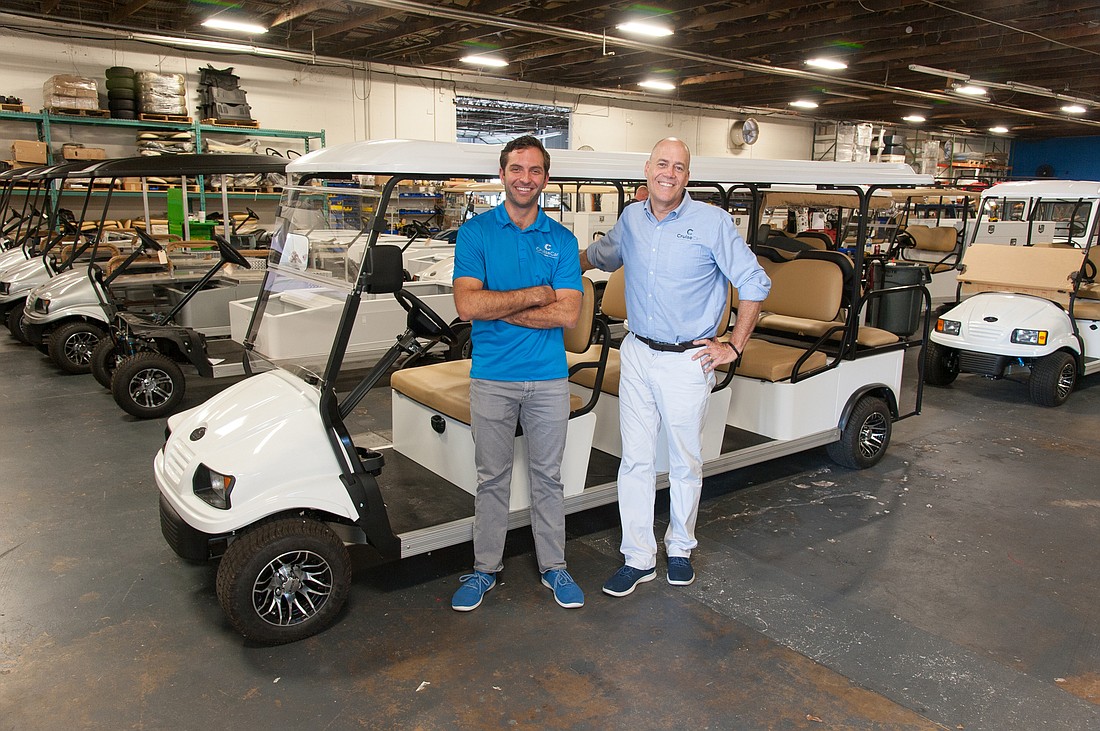- November 23, 2024
-
-
Loading

Loading

Adam Sulimirski says he’s allergic to the phrase, “Well, that’s the way we’ve always done it.”
As president and partner of Sarasota-based Cruise Car, he’s making sure that thinking is nowhere to be found at his business, from executive meetings in the office to the warehouse where employees manufacture the fast-growing company's low-speed vehicles.
Always looking for new ways to do it has paid off well for Cruise Car, which was founded in 2004. Cruise Car’s growth — its payroll has jumped nearly fourfold, for one example, from four people to 15 in two years — comes on several fronts. Space, like employees, has also grown rapidly, from a 2,000-square-foot facility in 2017 to a 7,000-square-foot facility to an 18,000-square-foot facility today. And there’s already talk of another expansion. Ditto on rapid growth for sales: Cruise Car posted $1.75 million in gross revenue in 2017 and $10 million in 2018 — up 471%.
Cruise Car has even been approached by investment firms and is exploring the idea of taking on a partner as a way to increase cash flow and capture more market share. “It’s an exciting option to consider,” Sulimirski says.
The nimble company has implemented many changes recently, and it has more in the works, constantly chasing improvements and greater sales. That’s the advantage of being a small company, Executive Vice President and Partner Nathan Kalin says. There’s no red tape, so it can implement new ideas quickly.
Cruise Car has built a company around vehicles for specific purposes that can be customized, from seating to storage. It's an approved vendor with the U.S. General Services Administration, and its biggest clients are the U.S. government and military, universities, hotels and resorts, state and local municipalities, museums, airports and state parks. In particular, it has seen major growth from resorts, universities and municipalities. (It also now assembles electric Moke vehicles for Moke America.)
Beyond customization, the company recently scored a big win: Sourcewell, a cooperative purchasing program that works with government, education and nonprofit organizations, chose Cruise Car for a national program for low-speed vehicles makers, along with Yamaha and Polaris. “It immediately put us on the map with 55,000 municipalities and universities,” Sulimirski says.
A trend toward low-speed vehicles has also helped. The vehicles are appealing to a variety of organizations because of lower purchase prices and costs to operate compared to regular vehicles. Cruise Car vehicles range in price from $7,500 to $20,000.
Most people discover Cruise Car through word of mouth, Sulimirski says, and the company is working to further promote its name recognition through branding. Last year, for example, it added nameplates to the back of its vehicles.
Right now, most assembly is done in Sarasota, with some in Las Vegas. Then vehicles are shipped nationwide. Cruise Car used to outsource that part of the process, but Kalin says it started doing its own shipping and delivering six months ago. “It’s nice to have a branded truck show up,” he says. Plus Sulimirski says it allows the company to control when its vehicles get delivered.
'Just about everybody has an incentive to go above and beyond.' Nathan Kalin, executive vice president and partner, Cruise Car
Customers buy vehicles site unseen — a challenge but also an advantage for the company. Because Cruise Car doesn’t have manufacturing facilities across the country and has no third-party dealers, its overhead is lower. That means it can keep its prices competitive, Kalin says.
Calls come in worldwide from people interested in Cruise Car’s vehicles. Recently, an executive from Hong Kong Disneyland came to Cruise Car to place an order. “It’s exciting to see who finds us,” Sulimirski says.
When customers call, Cruise Car employees interview them about their needs and specific features they want. Sulimirski says they often tell customers about vehicles they made for similar organizations, following up with, “But you know what an improvement would be?” Cruise Car also collects customer feedback to determine what to incorporate into the next round of improvements.
Sulimirski and Kalin say the company is constantly working on streamlining. Warehouse employees are encouraged to suggest ways to shave off time from certain processes. “We’re always looking at the clock,” Sulimirski says. “Where can we cut time down? It’s always a game of catching up to our orders.”
To encourage efficiency, Cruise Car employees are incentivized with a bonus system tied into monthly production goals. It’s meant to both increase production and create a team environment, so employees share in success together. “Just about everybody has an incentive to go above and beyond,” Kalin says.
In its quest to continue growing, Cruise Car is also thinking about getting into retail sales. Cruise Car’s 90-day turnaround has kept it out of retail so far, but it’s working to reduce it. That involves managing cash flow, so it has existing inventory, Kalin says, and that’s the biggest challenge with growth — cash flow in an inventory and materials-heavy business.
It’s easier dealing with a fleet order of 24 vehicles than an order for a single vehicle, Sulimirski admits, but that doesn’t mean lower-quantity sales aren’t valuable. “We’re not into sales prevention,” he says. “Every sale is great.”